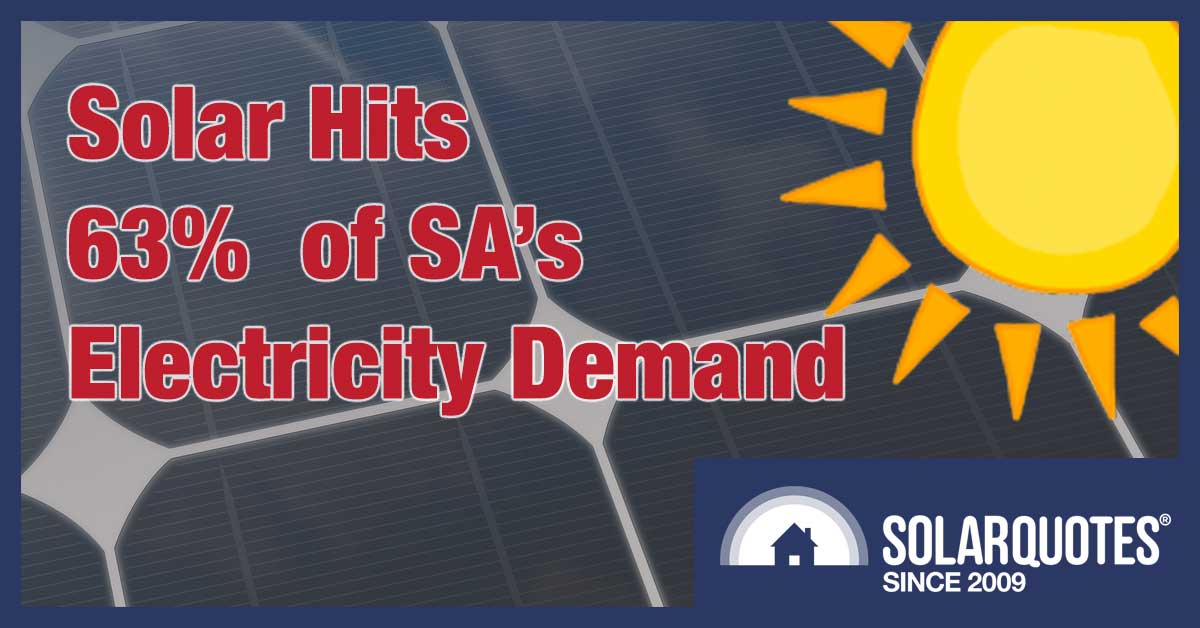
South Australia’s Rooftop Solar Now Meets Over 60% Of Electricity Demand At Times
On Sunday, rooftop solar provided 60% of all South Australian electricity demand in the middle of the day. This makes SA the most solar powered state by far and puts it well past the point where we were told solar power would destroy the grid, cause your lamb roast to cost $100, and make your cows spin backwards. It’s a big increase from last year when the highest figure I heard was 48%. Sunday’s percentage was so high it was off the chart.
Specifically this chart by the Australian PV Institute:
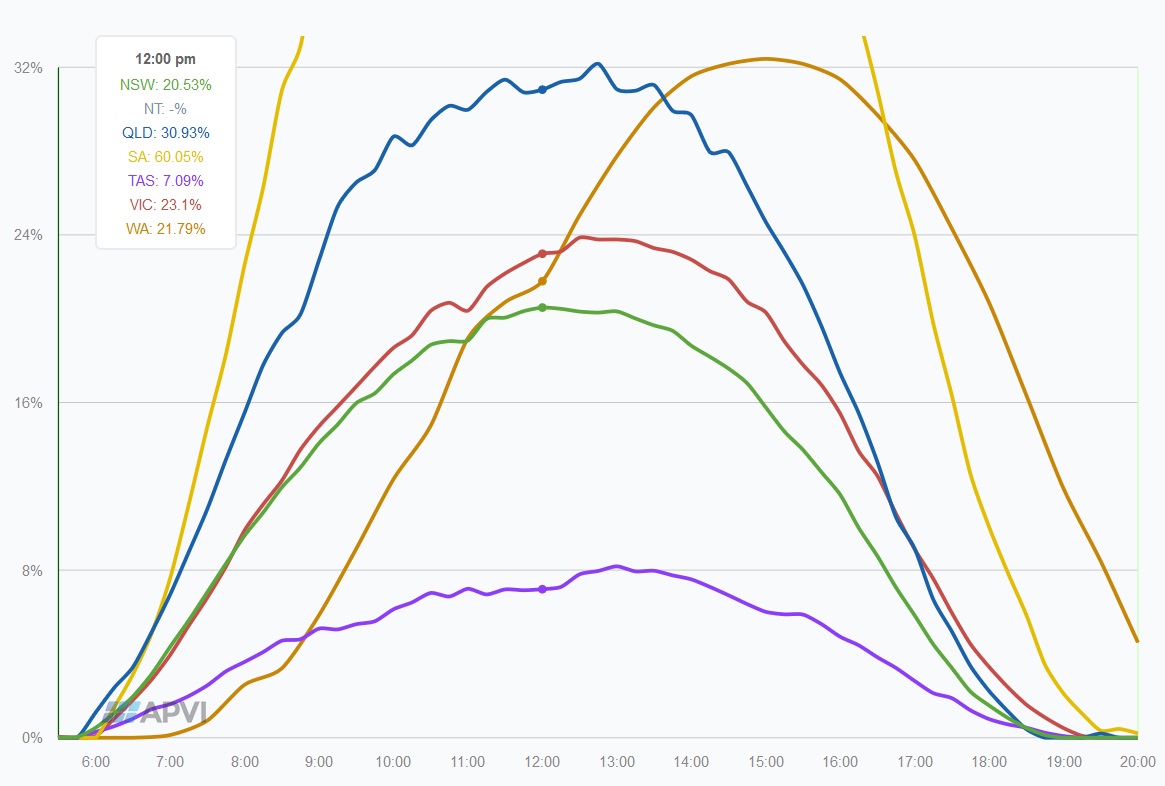
(Image: Australian PV Institute)
This shows the percentage of total electricity demand met in each state by rooftop solar power at 12:00pm South Australia time. Because it has busted the chart you’re not able to see that for at least 4.5 hours from 10:00am to 2:30 rooftop solar met over 50% of all electricity consumption. The figures don’t include output from large solar farms and as they were providing over 100 megawatts of power at noon, South Australia would have been around 75% solar powered.1
While the figures for last Sunday were good, on Sunday the 30th of September rooftop solar provided over 63% of all electricity use in the state at 11:30am. This graph shows on that day rooftop solar provided at least 50% of electricity demand for over five hours:
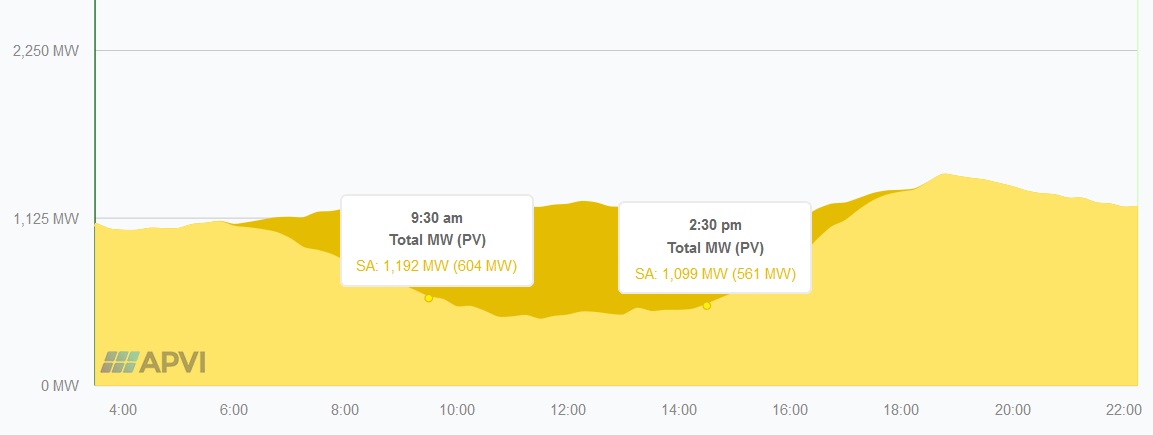
(Image: Australian PV Institute)
These two days were not freak events. Over the past 100 days there were 4 on which solar met over 60% of demand and a total of 25 in which rooftop solar provided at least 50% of electricity demand for a period of time.
Rooftop Solar Capacity Is Up
In South Australia 32.1% of homes now have solar panels on their roofs. SA no longer has the highest penetration in the nation as Queensland has pulled ahead with 32.6%. But SA is still in front on rooftop solar capacity per person and thanks to Queenslanders using far more energy, the murder mystery state generates much more of its electricity from it.
South Australia’s residential and small-scale commercial rooftop solar capacity is expanding rapidly and getting close to 1 gigawatt. Add in large scale solar farms and the state has a total of around 1.3 gigawatts of solar panel capacity. This is enough to provide around 13% of the state’s electricity consumption. This graph from the Australian PV institute gives a breakdown of the capacity figures:
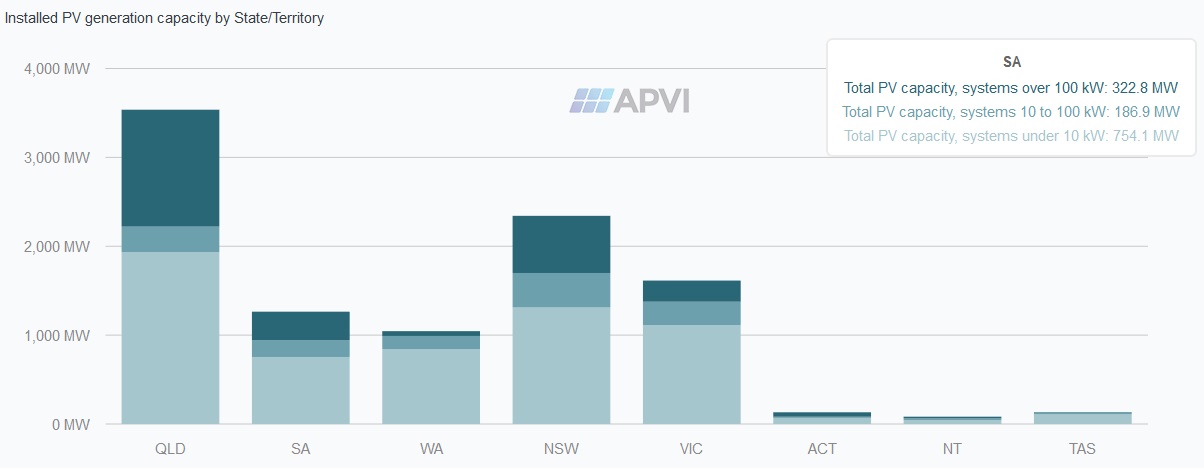
(Image: Australian PV Institute)
The graph was last updated on the 25th of October, so the figures are a little higher now.
Minimum Demand Is Down
Rooftop solar reduces the amount of electricity the grid has to source from power stations. On Sunday, the minimum power these stations supplied in South Australia was 705 megawatts:
The table below shows it is considerably lower than the minimum in the second quarter of the year since South Australia became part of the National Electricity Market in 1999:
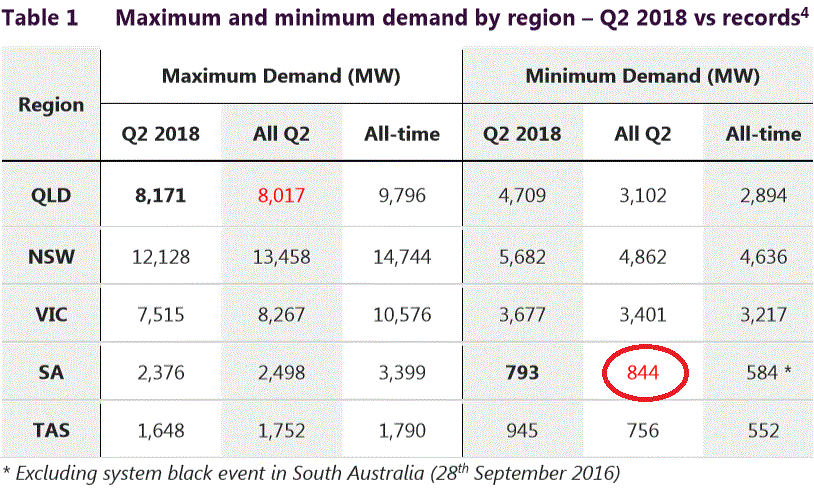
(Image: AEMO)
It was even lower at 595 megawatts on Sunday the 21st of October, which is close to the lowest figure for the past 20 years.
Typically, Australia’s coal power stations can’t lower their generation below 60% of their capacity and are unable to easily start or stop. This means they cannot shut down to avoid low prices caused by solar power in the middle of sunny days, which makes it very effective for driving coal from the electricity market.
Spring, Autumn, And Weekends Best For Setting Records
Of the four days on which rooftop solar met over 60% of demand, three were Sundays and one was a Saturday. Because electricity consumption is lower on weekends, records are more likely to be broken then. Despite this, of the past 25 days when rooftop solar met over 50% of demand 11 were weekdays.
Spring and autumn are also good times for solar power to set records. While longer days in summer means solar produces more kilowatt-hours, greater electricity consumption from air conditioners results in it meeting a smaller part of total demand. High temperatures also cut the maximum output of solar panels by lowering their efficiency.
This Month’s Figures May Be Increased
The Australian PV institute looks at how much solar capacity was installed each month and, if required, bump up their figures for the percentage of demand met by rooftop solar. So this month’s figures may be even better than they seem and rooftop solar power may have met over 50% of demand on more than 25 of the past 100 days.
Rooftop Solar Reducing Gas Use
Even when solar output is high, South Australia still generates a considerable amount of electricity from natural gas and at times large scale renewable generation is reduced to accommodate it. This curtailing of renewable output occurs because a certain level of gas generation is deemed necessary to give grid stability. Fortunately, this level will be reduced because batteries have demonstrated they can help support the grid and also because synchronous condensers will be built. These are big spinny things that help stabilize the grid without needing to burn gas.2
While some gas capacity is required to be kept operating at all times in South Australia, expanding renewable capacity is reducing the total amount that is burned.
Records Will Continue To Be Broken
Installation rates for rooftop solar panels are high and costs are still dropping. As a result, capacity will continue to expand and records will continue to be broken. How quickly fossil fuel generation is replaced with clean solar power mostly depends on whether politicians and regulators remove existing barriers or if they erect new ones. Tragically, my impression is far too many of them think their job is to protect the status quo rather than to protect us.
I’d describe our current situation this way — if you discover a lunatic is pumping poison into your town’s water supply you should do everything you can to stop it as soon as possible. What makes no sense at all is doing nothing while you discuss how slowly you can reduce the flow of poison so as not to damage the pump.

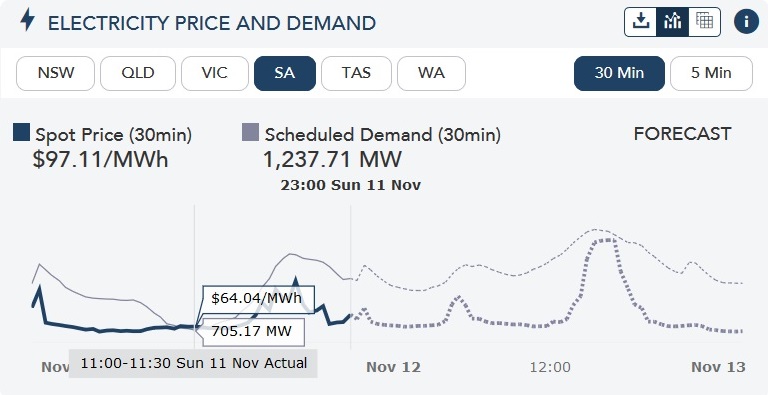
 RSS - Posts
RSS - Posts



Ronald
As a proud member of the ACT I note that there are no data for the ACT. Is this based on the premise that Canberra’s energy is completely supplied by the hot air generated by the itinerant politicians that plague us in our idyllic city?
Gerry
Well, I thought it was because they just didn’t monitor there, but Canberra’s electricity is the cheapest in the nation…
Hi Gerry, Ronald
Well, going back a few months, my inverter, too, was being throttled back heavily due to local phase voltages approaching 254Vac RMS – the SMA inverter manual says it commences throttling at 250 V, and is fully throttled (shut down) at 255 V on any phase. I asked Western Power if they could drop down the tapping on a local transformer & balance the phase generation, but they said they couldn’t as other customer voltages would fall below the regulated minimum of 240V – 6% = 225.6 V, and cannot intervene re- generation impact (which I found all hard to believe). Interestingly, following intervention by our State Energy Minister, the phases have now been balanced at my property, and reduced to a maximum of about 244 Vac.
Ronald – I think it’s great that SA has so much demand met by PV – but at what cost? I’ve read that Nuclear can produce power at an Operational Cost (after Capital has been amortised) of about 3 US cents/unit, say 4 c/unit Australian – without subsidy. Would appreciate your thoughts on this.
I did study Nuclear Engineering in 1969 – and feel the “game plan” may change significantly once the new Gen IV reactors go commercial (they can “burn” most of existing nuclear waste). The big issues for Nuclear have got to be Capital cost (could do with 50% subsidy, like other technologies), and competing with Coal.
Like you said, we want to stop poisoning our Planet – yet we sell coal to China and India – for them to burn. I recently heard (from an “expert”) that coal is a very, very expensive option – I guess that’s why India and China are building coal-fired stations as quickly as they can – to increase costs???!!!
Hi. The actual voltage range is 230V -6% +10% so Western Power were not correct in the advice they gave you. The voltage can be as low as 216V and still be in range.
Regarding nuclear power, the UK is still paying for the very first Watt of electricity produced by the worlds first ever nuclear power station. Cleaning up the mess after decommissioning costs a lot of money which will go on for thousands of years. How can nuclear power ever be cheap under these circumstances.
With respect Steve – not correct.
I’ve checked Western Power’s technical rules here in WA, and the low voltage distribution limits are 240V +6% – 6%, that is 226-254v. More variation allowed for maintenance, and more again in emergencies.
Re- nuclear, I’m concerned that much folklaw is based on emotion, rather than hard science – no disrespect. The costs of decommissioning have to be included in the total costs to be amortised – as for all technologies (even your family car!).
Why, otherwise, is the UK planning 11
new nuclear reactors at the present time, and the US 14? China plans 41, 18 under construction. Have they all got their financial analyses wrong?
You are right Ian. WA has not yet adopted the standard for 230V. See
https://electricalconnection.com.au/when-voltage-varies/
I didn’t realise that the cost of building a nuclear power station also included the cost of storing the radioactive waste for 30,000 years or more. .
I think people have missed the point regarding Gen IV reactors. Some Gen IV reactors (specifically the LFTR) can consume the radioactibe waste from conventional, or heavy water, nuclear reactors. Their own radiactive waste is relatively safe – hundreds of years half-life and emitting alpha particles which can easily be contained. Alpha particles can be stopped by a sheet of paper.
LFTR technology is particularly appealing and inherently safe. No core meltdown is possible. These are the type of reactor China is developing 40 of, and when they do they will corner the market in certain isotopes used in medical circles.
Not only that, a LFTR can be used to extract CO2 from the atmosphere and create conventional vehicle fuels like diesel or ethanol.
For a brief explanation of LFTR technology look at
https://www.youtube.com/watch?v=uK367T7h6ZY
Wkae up world, LFTR is the answer!! Why it isn’t being considered is a good question for our politicians, and world powers, to answer.
Hi Ian,
Both India and China are expanding coal-fired technology for short to medium term political necessity reasons., as well as moving towards renewable sources of energy as fast as their circumstances allow.
On the one hand, they have an urgent need to bring vast numbers of people up to a ‘reasonable’ standard of living quickly, and a major factor in that is the need for ‘additional energy’ regardless of how its sourced – be it nuclear, hydro, coal, natural gas, burning cow dung, adapting a bicycle to generate enough power for lighting so at least the kids can see enough at night-time to study and do their home-work or what ever other ingenious method they can think of.
So.. what would you do if you were a political leader in such a country in order to avoid political and civil unrest on a scale undreamed of in Western countries?
From their point of view, building a coal fired plant not provides a large number of jobs during its construction along with infrastructure of all kinds – power poles, roads, better communications, sewage systems, etc. You’ve also got a lovely big structure being built that can be seen from miles away and is thus a very obvious symbol to the surrounding ‘general public’ that ‘something is being done’.
As well, you can’t put solar panels on the roofs of tin shacks, bamboo huts nor the tarpaulins they might use to provide a ‘covered outdoor area, But you can at least light a fire to cook your meals on if a cheap coal supply is available . India in particular also has to deal with what could loosely be described as ‘terrorism’ for a long term, and more recently with ‘refugee influx’ from Bangladesh
But the same leaders are also very well aware that ‘clean’ energy is the future because in the longer term,because environmental pollution in those countries in some regions is already so bad its unbelievable.
If you visit the websites for Adani Power and ‘Adani Solar’, you will clearly see this duality I’m referring to.
What ‘criteria’ their respective political and business leaders might use to ‘juggle’ all the competing pressures – both short-term and long term – they face at any one moment, I don’t have a clue. But I sure would not like their job.
Hi Des
Yes, I’m sure you are right – it’s a difficult balance.
I note that China have 41 nuclear reactors planned, 18 in construction.
India has 6 under construction, 15 planned.
Maybe their development route is to build and use heaps of coal-fired power at the get-go (with much radon gas emissions, and mothers expressing mercury in their breast milk – like is happening in the USA as a consequence of coal-fired plant), then reduce this by introducing Nuclear power onto the then-developed national grid – then start to introduce RE after 30-50 years have passed????
I don’t have the answers, only queries, but I did observe the Doel Nuclear plant in Belgium on a river cruise – everything looked pristine, with about 2,905 MWe of electrical power being produced, and a lot of steam (almost always being shown by the media as pollution). This 1 plant would appear close to adequate to power SA’s entire demand – although I’d think without adequate redundancy. I do know a lot of neutrinos are also produced – although these actually pass through the core of earth and back into space while hardly ever interacting with anything (miniscule nuclear cross-section). In 2011, this plant (4 reactors), whislt not the biggest in Belgium, produced 22,789 GWh according to Wiki, and is their lowest-cost source of power.
I do agree with others, that the cost of decommissioning, and storing waste has to be included into the cost equation (and I don’t know if Belgium – and the UK – have done this, but I’d think they must know of the issues so may have). The nearly-commercial Gen IV reactors appear to burn waste from these earlier types of plant, and to be inherently fail-safe by virtue of their design (not like Chernobyl, Fukashima). Plus, modular – so can be built in volume in factories with considerable cost-breaks. Also sized to suit smaller population centres.
I’m not at all clear on how we should best be moving forward – but we can’t just put our heads in the sand – this is all happenning…
Hi Des
One thing I didn’t mention – but meant to and should have in my earlier post:
Around the same time I noted huge numbers of wind turbines – both in-service, and being constructed in Belgium and the Netherlands (especially around Antwerp harbour). A great result for RE. However, I also noticed the great variablity of their output – sometimes fairly powering around, othertimes stationary – often some feathered even with wind blowing (obviously, some for planned maintenance – but too many for this reason alone). However, I don’t know if Belgium still considers nuclear to be their lowest-cost power source.
Apparently this variability is hard on gas turbine plant providing the in-fill power – I understand due to the higher frequency of thermal cycling than their designs had allowed for.
In Myanmar, at poor villages around the Irrawaddy River I noticed the odd solar panel (on the ground and equipped with alligator clips, but amougst tall trees) being used to charge small car batteries – the batteries being then move and used with inverters to run microwave ovens – on occassion.
So, I take your point about developing the standard of living, which obviously needs a great injection of education (and we saw that too – at monastries).
Ron talks about poisoning the planet – one thing I didn’t like at all, was that plastic bags and other packaging were being strewn along the riverbank – and periodically simply being burnt. The fumes in the air were eye-watering.
Ok, a bit off-topic for Solar PV – but I am not aligned at all with any particular technology, and think we have to consider ALL options, and also be realistic about each of their true overall costs to the country, and to the world. I actually like the idea of PV – have a system myself – but get put off by the numerous urban myths and fake statements – you know, get “free energy from the sun”, “never pay a power bill again”, “fill (your electric car) for free, and never pay for petrol again”. All to some extent true, but grossly misleading – and in my mind, acting against the best interests of both the public, and the RE industry.
Hi Ian,
According to this April 2018 article I found at : https://www.reuters.com/article/us-bel%5B…]s-it-exits-nuclear-power-idUSKBN1HR1U3
” Belgium will double the area of its North Sea waters made available to offshore wind parks after 2020, the government announced on Friday, as part of its exit strategy from nuclear power. ”
Holland has been using ‘wind power’ as an energy source for a very long time (think windmills) – and in 2017 the country had an installed wind power electricity generation capacity of 4328 MW, which is about 900% more than the 481 MW they had in 2001
The ‘ocean sailing’ fraternity use marine grade ‘micro’ wind turbines on their boats to provide electricity for lighting and so forth, but those don’t come cheap. On land, a 1 KWh propeller style turbine suitable for a remote homestead is going to cost you nearly $10,000. The output voltage is 24 volt , and it weighs 55 kg.. I wish anyone who gets one the best of luck with their self -installation, electrical wiring, and regular maintenance routine.
The ‘conventional wisdom’ is that you are far better off to simply install more solar panels instead of adding a wind turbine or some other source of energy and ending up with a ‘hybrid’ system of some kind . I don’t fully agree with that myself because:
: Rapid change exists elsewhere, its not limited to just PV technology
: Wind-turbines come in different types, and have the advantage that you
can generate power day or night provided there’s some breeze around.
: Vertical axis wind turbines seem to have potential for providing enough energy to power small appliances, recharge lead acid batteries etc at a low cost. Although technically they may not be as ‘efficient’ as a solar panel, the fact they can run night and day can make up for that, because it more or less has twice the available production time of a solar panel
If you do a search using the term ‘red spiral vertical axis wind turbines’ you’ll see where one has been installed on the roof of a school in Victoria. There are other varieties of vertical axis turbines around too Try searching using ‘darrieus wind turbines’ and cycloturbine’ to see some other types which seem quite effective
There’s a lot of useful tips to be found on various ‘survivalist’ and ‘home-stead’ type websites too.
Ian, India and China aren’t building coal power plants as fast as they can. While India’s coal consumption has been increasing China’s coal consumption has been fairly flat over the past 3 to 4 years. New coal power plant construction is stalling in India and in China has been low for a decade compared to new wind and solar capacity. This article has some graphs on it:
https://www.bloomberg.com/opinion/articles/2018-06-14/china-india-coal-use-alternatives-are-rising
Electricity from the UK’s new Hinkley C nuclear power plant that’s under construction at will provide electricity at a minimum wholesale price around 19 cents per kilowatt-hour. That’s in a country with an existing nuclear industry. Clearly it’s a complete no go here.
Hi Ron
As I am to understand, India was increasing Coal-fired generation at a rate of around 20 GW per year in each of 2014, 2015, and 2016, but this was dropped to 9 GW in 2017 (69 GW). But I do note they may close 50 GW by 2027, due to plants no longer meeting their new air quality standards.
Apparently, though, India will need 850 GW of capacity by 2030, and it is anticipated 41% (350 GW) will hopefully come from Solar Plant with storage, and another 16.5% (140 GW) from wind.
China had previously frozen construction, apparently more as a consequence of over-supply. There is now reportedly satellite evidence (August), that there is about 46.7 GW of new and re-started construction underway – increasing China’s total coal-fired capacity by 4% – driven mostly by a 9.4% increase in demand – Shandong alone having a shortfall of 3 GW. A rebound?
Britain’s Hinckley Point C EPR (European Pressurised Reactor, not the new Gen IV type) had an estimated capital cost of ~ 20 billion pounds! I’d think Britain must have had a very good reason for approving this construction – and perhaps that was due to a priority to reduce carbon emissions? Due to start producing by 20115. 19 c/unit wholesale does appear very high – but I’d bet that most of that is to recover the huge capital cost.
But – I am having some trouble reconciling that figure, with Google data of Britain’s “Levelised costs of low-carbon electricity generation”.
In their 2011 estimate, these were 9.6 c/unit for nuclear, 34.3 for solar PV, 16.9 for offshore wind, and 8.3 for onshore wind. In their projections for 2040, these figure change to 6, 8, 8.5, and 5.5 respectively.
On this basis, nuclear looks pretty good, and PV and offshore wind not so good? Maybe there’s an allowance for dispatchable power? Of course, we have more sun!
Game may change with the advent of Gen IV reactors – maybe? Lack of an existing industry then less important.
Lazard now puts the levelized cost of large scale solar at 3.6 to 4.4 US cents per kilowatt-hour.
https://www.lazard.com/perspective/levelized-cost-of-energy-and-levelized-cost-of-storage-2018/
Clearly both coal and nuclear are going to have a hard time competing.
Wow Ron – that same Lazard levelised cost report paints an pretty abysmal picture for residential rooftop PV – costing about 21.3 to 35.6 cents/unit (Aust.). Must be because these are a relatively disjointed, disperse, and a less optimised use of capital? And heavily subsidised from our tax dollar?
I have to be honest and admit I don’t know how the “Levelising” process is done – had thought it may reward technologies according to their rate of greenhouse gas emission reductions, and penalise costs that need to be added to allow them to operate (e.g. synchronous condensers, batteries, network upgrading, etc.) – also the rate at which they can recover capital costs to implement.
However, I’ll admit the nuclear figures look challenging – but it must be just who you talk to, as these are significantly at odds with the British figures – which also show PV to be very costly at the present time (but will improve in the future).
I’m a little confused about the “marginal” cost shown in the 2nd graph of the Lazard report. This shows nuclear as US 2.4 to 3.1 US c/unit, to be better than even subsidised thin-film Utility-level PV, at around 3.2 US c/unit? Residential rooftop PV not even considered!
I’m thinking the “levelising” process may be very country, and region specific – we have more sun in WA and SA, so may show up better than Britain, and much of the USA (I worked north of Detroit for a couple of years – it was often cold, and dark – and the sun is very seasonal)?
So – I do not yet agree that nuclear is necessarily going to have a hard time competing – we haven’t seen much utility-level thin-film PV here in Australia that I am aware of, and at the present time, residential PV seems to be well-and-truly the worst (highest cost) of ALL available options – according to the Lazard figures. But, I do believe Coal is going to have to be phased out soon, or become very costly (sequestration additions?), so will be challenged in the long run for contamination (poisoning) issues.
To conclude – and independant of the financial issues – I don’t like the huge range of mis-information and exaggeration that is being circulated as fact in the media and elswhere, probably mischeviously, concerning nuclear power.
Sure, we know waste products are a serious issue, but this is usually vastly over-blown – there is not much of it (in the US, it is all being stored on site – for plant that have been operating for 40 years or more), and most waste has a short half-life, such that it drops to background levels in tens of years. VERY little has to be protected for 36,000 years. Newer technologies are much safer, and burn more of the fuel more efficiently leaving less waste. Gen IV reactors will even be able to burn waste from existing plant. All projects are required to consider whole-of-life costs these days. Security CAN be dealt with. These are all just Engineering and Management issues.
So – while I am not at all aligned with Nuclear – I’m just a semi-retired professional engineer – I do not think we should be throwing the baby out with the bath water. I’d rather all technologies compete on their merits – and if nuclear, or PV, or any other technology does not then prove cost effective, so be it – go for something else.
Ian, residential and commercial scale solar looks bad firstly because it allows a home or business to avoid paying the retail cost of electricity rather than the wholesale cost. Secondly, it is much more expensive in the US. In Australia it is possible to install decent quality solar for $1,000 a kilowatt. This article shows how STCs are calculated:
https://www.solarquotes.com.au/blog/gst-solar-calculated/
So the full cost of rooftop solar is pretty low here. This article goes into the pay back times for each capital:
https://www.solarquotes.com.au/blog/solar-payback-times/
They are even better now than since the article was written.
Note I’m not saying nuclear should not be allowed to compete, I am saying is no one can build a reactor that can compete. If other countries can build reactors that can are competitive then we will know it can be done. But I don’t think that will happen.
It would be worth asking how many roof top solar owners in Sth Australia are shut out of supplying power to the grid because rising voltage due to high current production causes systems to shut down. I think this is the tip of the iceberg that the grid was never designed to accommodate such a random uncontrolled supply.
Well, if you look at the differences between maximum and minimum demand at night when solar isn’t operating you can see the grid is made to accommodate large variations in supply and demand. Unfortunately, at the local level, there is both a financial and operational incentive to keep grid voltage levels high.
I totally agree. Most solar owners don’t realise that their systems are designed to shut down when the grid voltage hits a certain level. 256V for many inverters. Where I live, this voltage is exceeded on most days and can be much higher with the potential to damage equipment. The solar contribution could be much higher if the grid voltage was lower. Secondly, the new solar export limits will also have the impact of reducing solar contributions to the grid. For example, if you have 6.5kw of solar, and you want to increase the number of panels or adding a battery, you will only be allowed to export 5kW.
Surely, given that rooftop solar is powering 60+% of state demand, the intuitive answer is “not many”.
There is no way of knowing how many solar inverters shut down or reduce output due to high line voltage, but what is known, is that most inverters will reduce output or shut down at around 256V and this voltage is exceeded on most days. It would not be hard for the transmission companies to reduce the line voltage by 10V, but they don’t, which is good for the power generators.
The privatisation of our electricity in SA has lead to a monopoly and instead of the lower prices through competition we were promised, we have prices that have risen so fast that they have lead to businesses having to shut down. I know a number of them personally that this is the case so at least the days of us being fleeced through government incompetence are numbered.
I agree. Privatisation of the electricity market has been a disaster and not at all in the best interests of the population and industry. This is why solar installations in SA have increased so much in order to mitigate power price increases. If you are going to wait for power prices to come down, you are going to wait a long time.
Yep, that sure is BLOODY TYPICAL OF ALL OUR POWER AUTHORITIES AUSTRALIA WIDE , wiith the ex essive connection of RTS on the average homes, it aint making what it used to !
Now add in the excess online solar being connected & lack of their own maintenance thereof the grid system [ by their paid contractors they have employed in many places to ‘ OFFLOAD THEIR DUE RESPONSIBILITY IS SO DISGUSTING its beyond any joke, beknown , now…
as with, the sub contracting off to new power supliers is another problem they all facce now ??? shit me, in our area of W.A, with a wet & dry season, the loads are so variable that nobody ever bothers to check and carry out the adjustments needed to be done as the old days ( of having a western power or Horizon power aerial line crew , testing it as per needed ??? ..
go on, anyone ;-
“ Who wants to attack us, of my comment give it a go .. lol, casue i am one of the local contractors of this area and have NOTHING AT ALL TO HIDE ? unlike many others do, today.. “
I still find voltages in this time of the year, as low as 216 and up + over 258+ in my town ? but eh, as long as they do not live here, who frucking cares,eh !
Hi,
I think that the % would have to be higher, as there is no metering (AFAIK) of people’s self-consumption. Unless SA have gross feed-in metering, the figures can only show how much (unused electricity) is exported from a solar system to the grid.
dRdoS7
It should be a close estimate as the Australian PV Institute looks at the actual PV generation from a sample of homes.